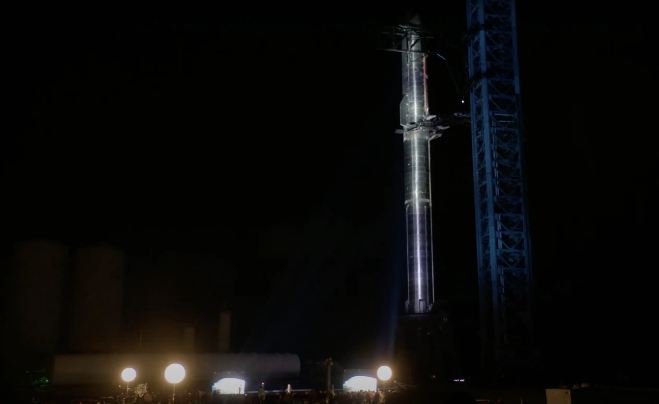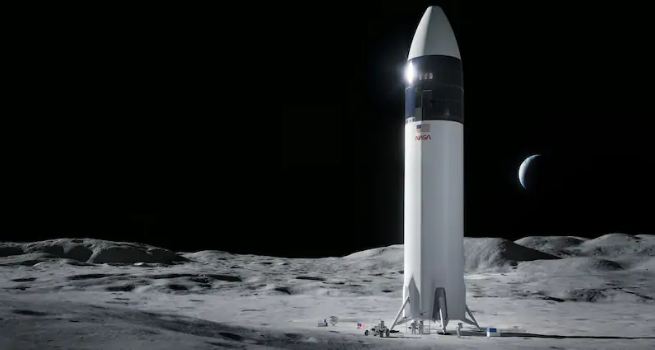[ad_1]
From a small scene a few meters away from his giant spaceship “Starship”, Elon Musk gave some new details Thursday night on his ambitious plan to reach the Moon and colonize Mars. Such a presentation was expected for months, but those who waited for important news and some new details on such a bold plan were disappointed.
Speaking of the development achieved by his space company SpaceX, Musk essentially repeated what he had already announced on other occasions, without revealing new or specific details about his initiative. SpaceX, so far, is the space company that makes the most launches each year into Earth orbit, thanks to its Falcon 9 rockets.
From Boca Chica, a large flat area in southern Texas overlooking the Gulf of Mexico, the company has built a Starbase, which is a large complex that will be used to build and test the new Starship spacecraft and rocket. Super Heavy, which will take it into orbit.
Over time, Starbase has grown, including numerous buildings and warehouses, but above all a large launch pad that turned out to be almost as difficult to design and build as the spacecraft, Musk explained, during presentation.

(SpaceX)
In front of an audience of SpaceX employees and some journalists, Musk began addressing a topic he had mentioned several times in his speeches: the need to make life “multiplanetary.” His idea stems from the belief that the future of human beings depends on the ability to colonize other planets and to do so, he says, requires much larger and more powerful spaceships than they are now, which may have the ability to transport people, goods and materials to Mars.
Starship, according to him, should be turned into the tool that can make this possible, but over the years Musk’s science fiction project has had to face reality several times, starting from the moment of its concretization.
In 2016, Musk speculated that Starship, might be ready to make an experimental unmanned journey to the planet Mars in 2022 and with people on board a few years later. Things went quite differently. The spacecraft was significantly changed and consequently the time for its construction. In September 2019, Musk said that Starship, could realize an orbital flight in the next six months, but now 30 months have passed and the spacecraft has not yet passed the Earth’s atmosphere.
During the presentation, Musk said the orbital flight is expected to take place this year, but gave no further details. In addition to technical difficulties, SpaceX has to deal with obtaining permits from federal agencies to conduct its own tests. An environmental impact analysis in Boca Chica and any other safety issues is still being analyzed by the US government.
Starship is 50 meters high with a diameter of 9 meters, so far has completed only a few important tests for launch, reaching an altitude of 10 thousand meters. In the last test conducted in early May 2021, the spacecraft was able to make a controlled landing, without exploding in contact with the ground, as had previously happened with other prototypes. Super Heavy, on the other hand, 69 meters high, has never flown, but has only performed a few tests of its 29 engines.

Musk then showed an animation, an updated version of what he had previously published, with the aim of illustrating how the release system might work. As previously announced, he expects the releases to be made with Starship, which mounts on top of Super Heavy. The large rocket starts its 29 engines and pushes the spacecraft beyond the Earth’s atmosphere, the latter, then performs a maneuver to return to Earth and reach the launch point again, where two mechanical wings have to task to capture it.
This way the Starship will be able to transport satellites and other materials into orbit, then returning to Earth as a Super Heavy. In the case of longer voyages, to the Moon or Mars, it will remain in orbit waiting to be reached and connected to another spacecraft to refuel in order to have enough supply to continue deeper into space.
The Starship will initially be used primarily for short trips to transport satellites into orbit, in order to control the operation of the system before flying with the crew on board. However, Musk has not provided new details on these aspects, nor how the interior of the large spaceship will be designed for astronauts and what systems will be adopted to protect them from harmful radiation, in the event of a several months trip to Mars.
In general, no new information has been provided about the predominant part of the project, which includes the trip to the Moon and later to Mars. The lack of details received a lot of criticism, especially regarding the missions that will be carried out in the future in space and that are related to Starship. This is not a trivial matter, as the project directly affects NASA.

Starship on the Moon, a Graphic Design (NASA)
In April 2021, NASA had in fact entered into a $ 2.9 billion contract with SpaceX to use Starship as a means of landing on the Moon as part of the Artemis space program, launched specifically to go to the Moon with a crew. Such a plan predicts that the landing on the Moon, the first with an astronaut, will be realized in 2025, but there are strong doubts that even NASA will have almost all the necessary equipment by then.
Beyond the difficulties and delays, Starship remains the biggest and most ambitious project at least for now in space exploration. Previously, SpaceX has proven that it can achieve excellent results and in very few years has brought significant innovations in the space industry, enabling the frequent launch of spacecraft at relatively low cost and this thanks to its rockets that can to be reused at least in part.
top channel
[ad_2]
Source link















